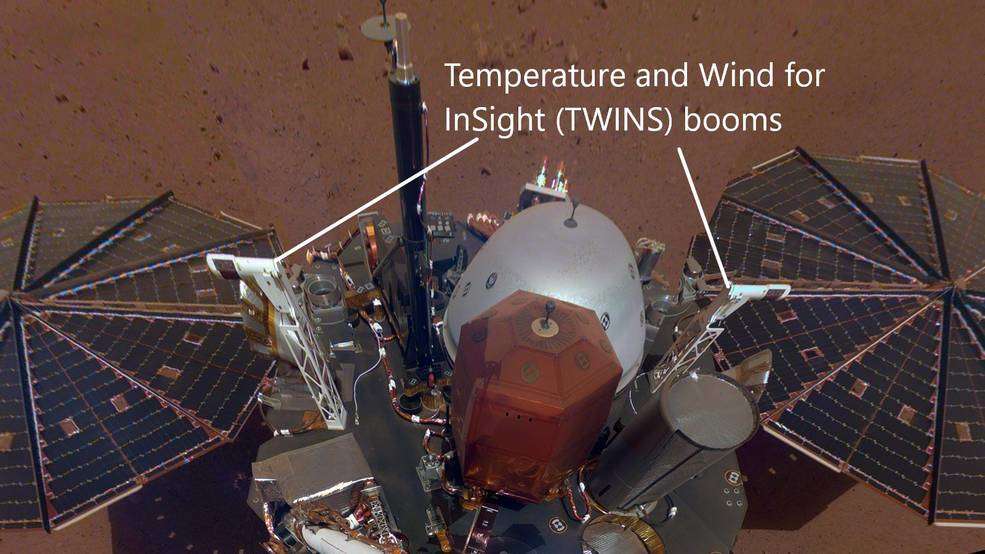A calendar system for Mars has already bean devised for potential future settlement. The calendar contains 24 months of 27 or 28 days each, named after Latin and Sanskrit constellation names.
Olympus Mons on Mars, the tallest…
Olympus Mons on Mars, the tallest known mountain in the solar system, is so large at its base that an observer on its peak wouldn’t know he was standing on a mountain because its slope would be obscured by the curvature of the planet itself.
First TV Image of Mars (Hand Colored)
During the Mariner 4 Mars mission in 1964, the scientists were so eager to see the first ever close up images of another planet that they printed out the numerical data and hand colored it with crayons instead of waiting for a processed image.
NASA Just Made it Possible For You to Check the Weather on Mars
Modern living has given us a lot of great things – smartphones, the internet, DoorDash. But this next one might be one of the best examples of humanity’s greatness and ingenuity. You see, you can now check the daily weather on another planet!
The reports are a part of NASA’s InSight Lander’s – short for Interior Exploration Using Seismic Investigations, Geodesy, and Heat Transport – mission, which is to give Mars a “checkup” of sorts. The robot is set to report temperature, wind, and pressure readings for the foreseeable future.

Image Credit: NASA/JPL
Mission lead Don Banfield reminds us that the lander “is close to the Martian equator – just north of the equator – so it is experiencing Martian winter.”
And Martian winter will have you saying prayers of thanks for the polar vortex you might be experiencing Earthside.
“I didn’t think we’d see any evidence of the storms that are 60-degrees north latitude, but we’re already seeing evidence of the high and low pressure-signal waves that create weather on Mars,” Banfield continues. “We can see those waves all the way down near the equator, as the waves are big enough that they have a signature. That was a surprise.”
Compared to the systems we see here on Earth, the high and low pressures on Mars are far less chaotic, but the coldest temperatures on the red planet average around -139 degrees at 5am. The sunrise heats it to around a balmy 23 degrees, though, so you know. Livable.

Image Credit: NASA/JPL
If you could breathe the air.
InSight will also be recording tectonic activity and meteorite impacts in real time, and monitoring the planet’s crust, mantle, and core.
If you’re one of those people who think colonizing another planet would be super fun, you might want to log on and start gathering your own data on what kind of clothes you’ll need to bring along.
But, you know. Warm stuff for sure.
The post NASA Just Made it Possible For You to Check the Weather on Mars appeared first on UberFacts.
There is liquid…
There is liquid water on Mars. The watery area in question is about 20 kilometers in diameter, and while depth can’t be determined, the deposit would likely have to be at least a meter thick to produce the reflection observed. So at a bare minimum we’re probably looking at a serious quantity of water, on […]
The first Soviet probe sent…
The first Soviet probe sent to Mars’ moon Phobos failed due to user error. While the probe was still on its way to Mars, an impatient technician who didn’t want to wait for his code to be proofread unintentionally sent a command to the probe to shut down and there was no way to turn […]
The first woman to have flown into…
The first woman to have flown into space(1963), Valentina Tereshkova, also volunteered in 2013 to go on a one-way trip to Mars. 00
There’s a team of NASA scientists who’ve been pretending…
There’s a team of NASA scientists who’ve been pretending they’re on Mars for nearly a year. They live and work in a dome on the side of a Hawaiian volcano and only go out in spacesuits.
If you stood at the equator on Mars, the temperature would be 21C…
If you stood at the equator on Mars, the temperature would be 21C (70F) at your feet, where the Sun had warmed the ground, but 0C (32F) at the top of your head.



